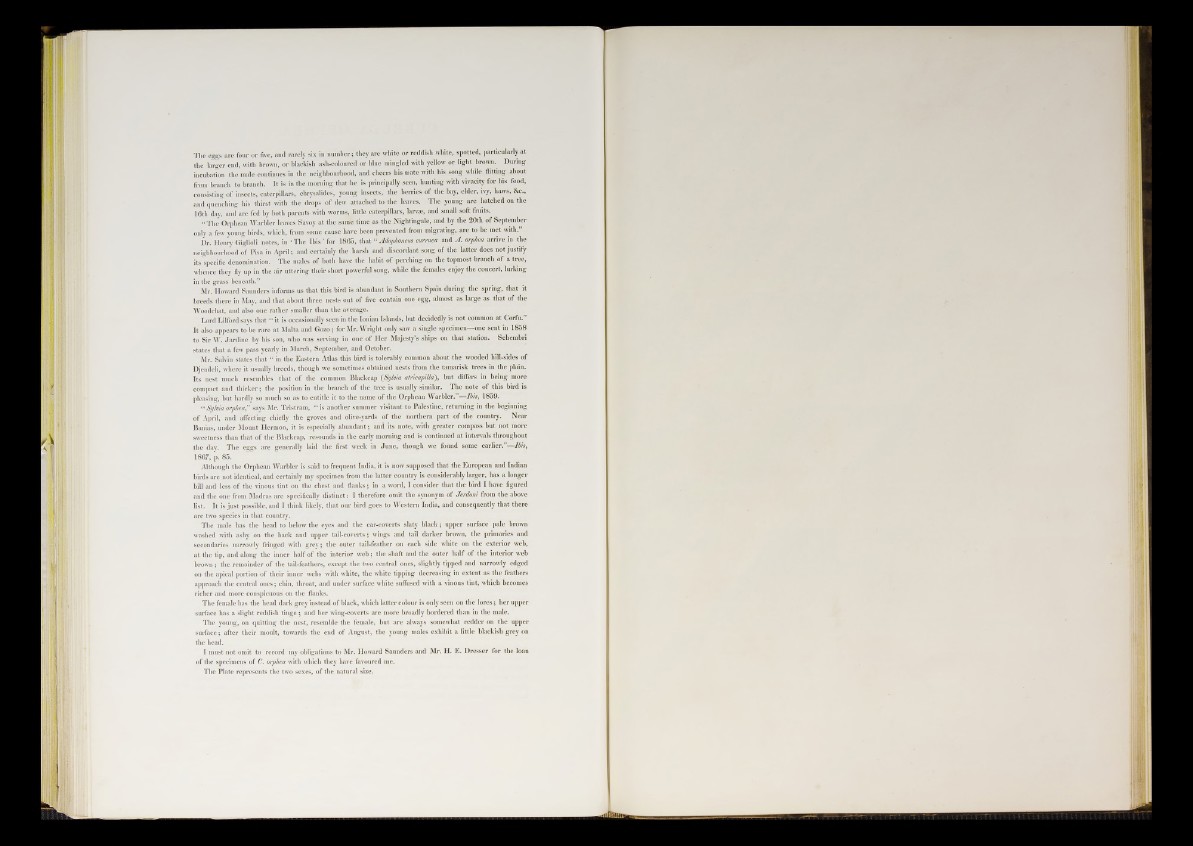
The eggs are four or five, and rarely six in number; they are white or reddish white, spotted, particularly at
the larger end, with brown, or blackish ash-coloured or blue mingled with yellow or light brown. During
incubation the male continues in the neighbourhood, and cheers his mate with his song while flitting about
from branch to branch. It is in the morning that he is principally seen, hunting with vivacity for his food,
consisting of insects, caterpillars, chrysalides, young insects, the berries of the bay, elder, ivy, haws, &c.,
and quenching his thirst with the drops of dew attached to the leaves. The yonng are hatched on the
16th day, and are fed by both parents with worms, little caterpillars, larv®, and small soft frnits.
" The Orphean Warbler leaves Savoy at the same time as the Nightingale, and by the 20th of September
only a few young birds, which, from some cause have been prevented from migrating, are to he met with.”
Dr. Henry Giglioli notes^jf ‘ The Ib is' for 1865, that “ Aiophmem curruca and A . orphea arrive in the
neighbourhood of Pisa in April; and certainly the harsh and discordant song of the latter does not justify
its specific denomination. The males of both have the habit of perching on the topmost branch of a tree,
whence they fly up in the air uttering their short powerful song, while the females enjoy the concert, lurking
in the grass beneath.”
Mr. Howard Saunders informs us that this bird is abundant in Southern Spain during the spring, th at it
breeds there in May, and that about three nests out of five contain one egg, almost as large as that of the
Woodchat, and also one rather smaller than the average.
Lord Lilford says that “ it is occasionally seen in the Ionian Islands, but decidedly is not common at Corfu.”
It also appears to be rare at Malta and Gozo; for Mr. Wright only saw a single specimen—one sent in 1858
to Sir W. Jardine by his son, who was serving iu one of Her Majesty s ships on that station. Schembri
states that a few pass yearly in March, September, and October.
Mr. Sal via states that “ in the Eastern Atlas this bird is tolerably common about tbe wooded hill-sides of
Djendeli, where it usually breeds, though we sometimes obtained nests from tbe tamarisk trees in the plain.
Its nest much resembles that of the common Blackcap (Sylvia atricapilla), but differs in being more
compact and thicker; tbe position in the branch of the tree is usually similar. The note of this bird is
pleasing, but hardly so much so as to entitle it to the name o f the Orphean Warbler.”—Ibis, 1859.
“ Sylvia orphea,” says Mr. Tristram, “ is another summer visitaut to Palestiue, returning in the beginning
of April, and affecting chiefly the groves and olive-yards of the northern part o f the country. Near
Banias, under Mount Hermon, it is especially abundant; and its note, with greater compass but not more
sweetness than that o f the Blackcap, resounds in the early morning and is continued at intervals throughout
the day. The eggs are generally laid the first week in June, though we found some earlier.”—Ibis,
1867, p. 85.
Although the Orphean Warbler is said to frequent India, it is now supposed that the European and Indian
birds are not identical, and certainly my specimen from the latter country is considerably larger, has a longer
bill and less of the vinous lint on the chest and flanks; in a word, I consider that the bird I have figured
and the one from Madras are specifically distinct: I therefore omit the synonym of Jerdoni from the above
list. It is just possible, and I think likely, that our bird goes to Western India, and consequently that there
are two species in that country.
The male has the head to below the eyes and the ear-coverts slaty black; upper surface pale brown
washed with ashy on the back and upper tail-coverts; wings and tail darker brown, the primaries and
secondaries narrowly fringed with grey; the outer tail-feather on each side white on the exterior web,
at tbe tip, and along the inner half of the interior web; the shaft and the outer half of the interior web
brown; the remainder of the tail-feathers, except the two central ones, slightly tipped and narrowly edged
on the apical portion of their inner webs with white, the white tipping decreasing in extent as the feathers
approach the central ones; chin, throat, and under surface white suffused with a vinous tint, which becomes
richer and more conspicuous on the flanks.
The female has the head dark grey instead o f black, which latter colour is only seen on the lores; her upper
surface has a slight reddish tin g e ; and her wing-coverts are more broadly bordered than in the male.
The young, on quitting the nest, resemble the female, but are always somewhat redder on the upper
surface; after their moult, towards the end of August, tbe young males exhibit a little blackish grey on
the head.
I must not omit to record my obligations to Mr. Howard Saunders and Mr. H. E. Dresser for the loan
of the specimens of C. orphea with which they have favoured me.
The Plate represents the two sexes, of the natural size.